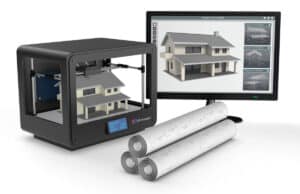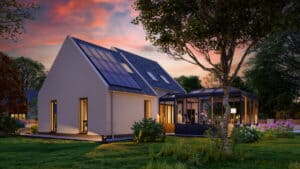Stay Up to Date on the Latest Advances in Construction Technology
The construction industry is constantly changing and evolving, especially when it comes to technology trends. Now more than ever before, tech advances are helping contractors build their customer bases and finish projects more efficiently.
Newer technologies can also provide more transparency and visibility into what happens on a jobsite. This can help customers feel like they’re making informed decisions and give them more confidence in their contractor.
From on-site construction technology to 3D printing, here are seven industry disruptors that should be on every contractor’s radar.
1. Augmented Reality (AR) to Improve Training and Safety on Jobsites
Augmented reality (AR) is the blending of interactive digital elements with real-world objects by using something like a smartphone camera (think Snapchat filters or Pokémon Go). AR is being used for a lot more than video games these days, though.  In fact, it can be used to drastically improve the training process and safety procedures on jobsites, as well as increase accuracy and efficiency in construction projects. For example, a member of your crew could be looking around your jobsite, and then get data layered on top of their view showing information on temperature, landscape and the worksite.
In fact, it can be used to drastically improve the training process and safety procedures on jobsites, as well as increase accuracy and efficiency in construction projects. For example, a member of your crew could be looking around your jobsite, and then get data layered on top of their view showing information on temperature, landscape and the worksite.
2. Virtual Reality (VR) for Risk Mitigation
AR’s cousin, virtual reality (VR), is a complete immersion experience that puts a user into an entirely digital world. This would be like putting on a pair of goggles and feeling as though you are actually moving and walking in different environments, completely removed from the world around you. Imagine being able to train and test on the jobsite and then reboot and start over — that’s possible with VR tools. This could make training a lot more specific to the actual jobsite, helping your team visualize the work without the risk of being in the field environment.
Contractors can even virtually walk through a jobsite before it physically exists. Because the tech allows contractors to create and problem solve projects in a virtual space before applying them on a physical jobsite, they see and resolve issues before ever purchasing materials or laying foundations.
3. 3D Printing to Prototype and Visualize Jobs
3D printing is a construction technology that allows you to create a three-dimensional solid object from a digital file. With greater accessibility to 3D printers, businesses are able to construct prototypes of jobs before getting to the actual site. This can help with visualization, concepting and project management.
 The technology might also lower supply costs and final customer prices, as well as reduce waste, because it uses a manufacturing process where only the necessary materials are used. This printing may also help with more streamlined customer communication because it allows you to provide a more realistic look at the final product.
The technology might also lower supply costs and final customer prices, as well as reduce waste, because it uses a manufacturing process where only the necessary materials are used. This printing may also help with more streamlined customer communication because it allows you to provide a more realistic look at the final product.
4. Wearable Technology and Connected Worksites to Streamline Processes
Another construction technology trend is finding solutions that connect those on the jobsite — whether that’s by streamlining projects, communication or processes. Connected worksites are quickly becoming the norm for contractors, and this often starts with wearable construction technology.
- Sensing wearables: This technology often comes in the form of badges and sensors that can be attached to hard hats, glasses, shoes and other personal protective equipment. The goal of these wearables is to monitor physical, environmental and biological conditions and provide data that informs you and your team members.
- Visual wearables: These glasses or other visual aids produce images for remote viewers and/or the person wearing the technology. This technology can be used to help with training and improves communication with off-site team members.
- Tactile wearables: These are suits that workers can wear to increase the user’s strength and durability, reducing the potential for strains and injuries. A progressive example might be a bionic suit that helps the wearer pick up heavy objects and easily operate heavy machinery.
5. Building Information Modeling (BIM) for Planning and Design
BIM is a 3D modeling technology that allows construction professionals to create and manage digital representations of buildings and their components. Its popularity in the construction industry has increased because it offers several benefits over traditional 2D blueprints and models.
BIM tools (such as HOVER, which ABC Supply customers can access through myABCsupply) can help identify potential conflicts or errors in the design phase, mitigating the risk of rework during construction. Providing an up-to-date model of the building can help improve communication and collaboration between different teams, which is essential for keeping a job on track. Lastly, BIM can help with project scheduling, cost estimation and materials management, leading to more accurate timelines and budgets.
6. Green Building and Green Construction
 Going green is more than just a buzzword these days, and in construction, the incorporation of green components is making serious headway. While green initiatives and tech aren’t necessarily synonymous, the incorporation of tech-forward materials and design is more frequently working its way into mainstream construction, making it something contractors should have a pulse on.
Going green is more than just a buzzword these days, and in construction, the incorporation of green components is making serious headway. While green initiatives and tech aren’t necessarily synonymous, the incorporation of tech-forward materials and design is more frequently working its way into mainstream construction, making it something contractors should have a pulse on.
According to the U.S. Green Building Council, green building is the development of buildings and application of processes that are environmentally responsible and resource-efficient for a building’s total life cycle. Said more simply, green building looks at the operations of the completed building as well as the design and construction. Green construction is solely about the construction of the building in an environmentally friendly way.
Some of the favored green building processes are:
- Designing a building to have minimum impact on the environment
- Obtaining LEED certification
- Installing efficient electric and water systems
- Installing air purification systems
- Sourcing nontoxic, ethical and sustainable materials
Some of the favored green construction methods are:
- Using more environmentally friendly materials (e.g., composite shingles; metal, clay or concrete roofing; solar)
- Using newer and more fuel-efficient equipment to burn less fuel
- Disposing of toxic materials in a safe way
- Reducing waste as much as possible
- Recycling as much construction debris as possible
When natural resources are at a premium and sustainability is top of mind, customers will be looking for opportunities for green building to reduce the overall impact to the environment. Another bonus? Green construction can be a cost saver in the long run.
7. Cloud-Based Software and Mobile Apps to Ease Ordering and Delivery Processes
Check with your supplier about the technology they have available to make it easier for you to order and receive materials. At ABC Supply, we offer several helpful tools, including:
- myABCsupply: Allows you to request measurement reports, conveniently order materials, confirm order details and check the status of upcoming deliveries (with notifications and photo confirmations when they arrive) to keep your jobs on track. Integrating with leading business industry software, such as EagleView, GAF QuickMeasure™, HOVER and AccuLynx Quick Order further streamlines your business needs. You can also manage your account, view statements, pay invoices and find an ABC Supply location near you.
- Pictureit: This project visualization tool allows homeowners to see what their finished projects will look like — hopefully making them feel more confident in their decisions.
Keep visiting the ABC Supply blog to learn more about how we can help you build your business.